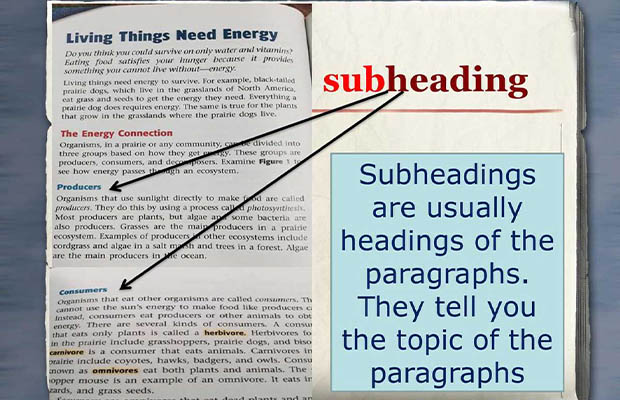What is a Subheading & How To Write It? Complete Guide
However, formatting and SEO tools rarely use subheadings, despite their importance. Find out the benefits of optimizing your subheadings and how to do it effectively.
First, what is a subheading? A subheading is a miniature headline that is placed thoughtfully within any particular written text. For instance, while subheadings are the specific titles of each writing section, headlines are the overall title.
Understanding what a subheading is, why it’s important, and how to make one by reading on.
Table of Contents
What is a Subheading?
A sub-heading is a mini-headline given to a subsection or paragraph within a main piece of writing. They’re smaller than the main heading but larger than the paragraph text of the article.
Sub-headings are often seen in non-fiction writing, such as an instruction text or an informational text. Following each sub-heading, they pique the reader’s interest and encourage them to read the rest of the page.
Texts would simply be lengthy paragraphs of text without subheadings. Reading through that was challenging! Read More: How Long Should A Paragraph Be?

Why Are Subheadings Important?
Crafting strong subheadings is important in your writing for many reasons, including:
Increasing Reader Retention
One advantage of using strong subheadings is that they can draw readers into each section, which can lead to an increase in reader retention. For instance, if you’re writing a blog post about travel advice, you might use keywords in your headings to entice readers to read the rest of the article. Subheadings can also aid readers in understanding the content if they scan your articles for pertinent information before reading, which may increase reader retention. They may be more likely to read your writing if it has intriguing subheadings.
Improving Content Organization
Subheadings can help readers find the information they’re looking for more easily, so they can also help you organize your content better. If you wanted to know how to train a particular dog breed, for instance, you might look for pertinent subheadings for how to train specific dog breeds within animal training articles. Because you can group information about particular topics together, adding subheadings can also help your content be better organized.
Strengthening Readability
By using subheadings to help break up your content, you can also improve how readable your writing is. This tactic is effective at keeping readers from becoming bogged down by lengthy paragraphs. Additionally, using subheadings will help you give readers a clearer idea of each section’s topic and give them a preview of what they can expect to read next.
There are some common mistakes writers make when writing subheads:
- not giving the section’s creation enough thought. It’s crucial to think about the section’s subject, its centerpiece, and the benefits the reader should derive from reading it. This makes it easier to create a subheading that offers the reader value, such as instructions on how to perform a task or lessons they will learn. They ought to be aware of what to anticipate in the subsequent paragraphs.
- not being clear and putting too much emphasis on creativity Though creativity is encouraged, it should never result in the reader becoming confused. In order for the reader to understand what you are saying, make sure it is well-explained. Delivering solutions, not confusion, is your aim.
- not following the rules of organization. Your content should follow a recognizable pattern. One, two, three, and four are the main headlines and subheadings, respectively.
- veering off topic. In order to maintain consistency and avoid confusing the reader, the subhead should always refer back to the main heading. Each subheading ought to delve more deeply into the text while still remaining connected to the headline.
The Big Three: Headline, Subheading, and CTA
These components all work best when presented together, even though they each have their own merits. The headlines are strengthened by subheads, and the CTA unifies the content. Here’s a good formula:
- Headline – Make them look twice
- Subhead – Pull them in to seek more information
- Call to Action: Describe what they should do next.
On a website, blog, article, etc., the headline is what visitors see first. It should make a compelling enough claim to pique the reader’s interest. They ought to be animated or do something that really attracts attention.
The subhead engages the reader even more and provides food for thought. They ought to be eager to read more. This is done by describing, outlining the advantages the reader will experience or how their quality of life will improve, or by enticing them to take some sort of action. The headline should serve as the primary source for the subhead.
How to Write the Best Subheadings?
Writing the best subheads requires practice. Here are a few tips:
Focus on the Organization
The content’s organization is crucial. It ought to make sense for the reader to understand. The phrases should contain keywords and natural links rather than being overstuffed. As it develops and the reader progresses through the content, it should flow and make sense. There is another structure that might be helpful even though this one doesn’t always make sense. Prior to them beginning to read, briefly summarize the main points. Then, as they read, highlight important words, concepts, or facts.
Separate the Content
Your headings and subheadings are crucial once you’ve organized and laid out everything. Make sure the headings are precise and descriptive. All of the information that follows should be described by the distinct subheadings. The reader should have a seamless experience that entices them to stay. You want them to read more of your content, take action, buy something, or give something.
Make the Headings and Subheadings Clear
The majority of website visitors won’t read your entire page. Many people will scroll through the subheadings to find the sections that apply to them, their requirements, or the inquiry they are attempting to answer. This is crucial to remember when writing because, even if you include the information they need in the body, if they can’t find it in a quick scan, they might choose to visit another site instead. So, make it clear to the reader which is which by differentiating the heading from the subheading. That includes the content’s size, as well as, in some cases, its color, font, effects, or a combination of these. Each one will be unique depending on the particular style guides.
The Shorter, the Better
Nobody wants to read a subheading that is overly wordy. Straightforward content is popular with readers. Cut any filler words that are unnecessary when writing in light of this. Having said that, longer subheadings are acceptable in some circumstances, especially if you are cramming a longtail keyword in. It’s crucial to maintain consistency in heading length across the entire piece of content. As they will stand out and possibly divert readers, avoid using a mix of short and long headings.
Use Graphics
Similar to subheadings, graphics are a feature that many readers seek out when reading blogs or browsing a business’s website. Depending on the type of content, graphics can increase the value you provide to your readers even more. The use of imagery in the form of graphics, grids, graphs, or pictures can significantly improve the explanation of the content.
Keep Your Brand Voice Consistent
It’s important to establish your brand voice early on in the development of your business strategy because it plays a key role in building brand recognition and brand loyalty. It’s crucial to maintain consistency once you’ve established the ideal voice for your brand throughout all platforms, including social media, and in all of your content, including subheadings. For instance, you wouldn’t want to surprise your audience by using more informal language in your subheaders if you aim for a more professional tone.
Take Away: Tips for Writing Subheadings
Here are some additional tips to help you write engaging subheadings:
- Be brief; a headline that isn’t long detracts from its impact. Your subheadings should provide a broad overview of what will happen without saying too much.
- It may be tempting to use corny jokes and puns as headlines, but refrain from doing so. However, this frequently prevents the reader from taking the information seriously.
- There should always be advantages to reading your content, so try to include some of these advantages in your subheadings. To make it simpler for the reader to follow the content, the subheadings in a piece about how to make shoes could be the steps themselves.
- Create a sense of urgency by writing subheadings that make the reader aware of the significance of the information and lay out the possible courses of action.
Read Next: How To Write A Book About Your Life?
